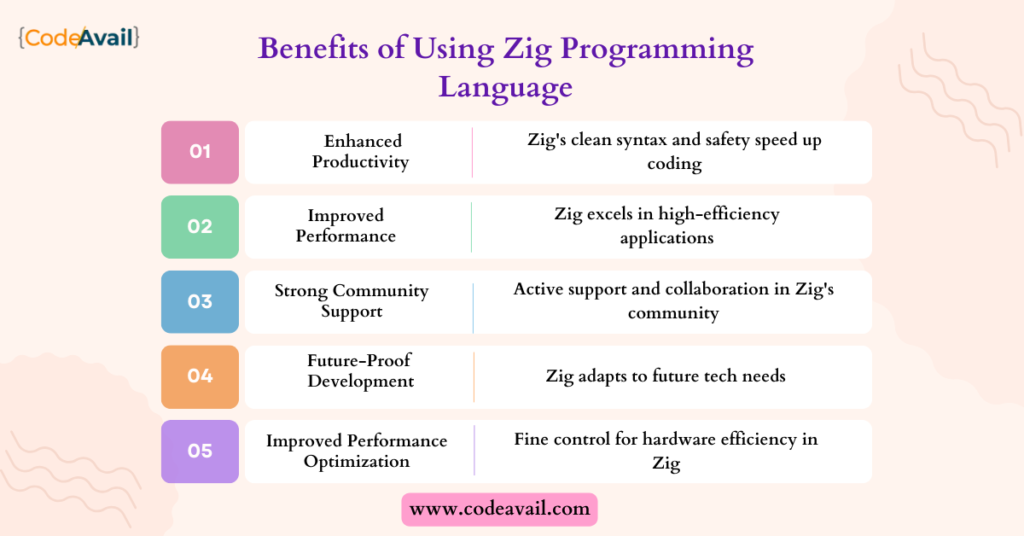Designed for performance, safety, and simplicity, Zig is a modern, general-purpose programming language. Developed with a focus on low-level programming, Zig combines the efficiency of languages like C with the expressiveness of higher-level languages. This blog will explore the fundamental aspects of Zig, including what it is, its key features, the benefits of using it, and its various applications. Whether you are an experienced programmer or just starting your coding journey, this blog will provide a detailed understanding of Zig.
Discover why Zig is gaining popularity among developers worldwide and how its unique features, such as performance optimization and compile-time memory safety, can revolutionize your software development process.
Stay tuned with us and learn about zig programming language concepts.
| Before we start discussing the main part of this programming language, if you are struggling with your any programming assignment, you can take programming assignment help from experts. |
What is Zig Programming Language?
Table of Contents
Zig is a modern programming language designed to focus on simplicity, performance, and safety. It combines the best features of low-level systems programming languages with high-level abstractions, making it an ideal choice for developing a wide range of applications. Zig’s syntax is concise and expressive, enabling developers to write clean and readable code.
Key Features of Zig Programming Language
Here are some key features of Zig programming language:
1. Safety First
One of Zig’s standout features is its emphasis on safety. The language provides compile-time memory safety, which helps prevent common programming errors like buffer overflows, null pointer dereferences, and memory leaks. By catching these issues at compile-time, Zig enables developers to write more reliable and secure code.
2. Performance Optimization
Zig offers excellent performance without sacrificing safety and ease of use. It provides fine-grained control over memory management, allowing developers to optimize their code for efficiency. With Zig, you can harness the full power of your hardware while maintaining a high level of abstraction.
3. Cross-Platform Compatibility
In today’s multi-platform world, programming languages must offer cross-platform compatibility. Zig excels in this aspect, providing seamless integration with various operating systems, architectures, and compilers. Whether you are targeting desktop, mobile, or embedded platforms, Zig has got you covered.
4. Interoperability
Zig enables easy interoperability with existing C libraries, making it an excellent choice for projects that require integration with legacy codebases. Its compatibility with C allows developers to leverage a vast array of established libraries and tools while enjoying the benefits of Zig’s modern design.
5. Extensive Standard Library
Zig comes with a rich standard library that provides a wide range of functionality out of the box. From file I/O operations to networking, Zig’s standard library offers comprehensive support for common programming tasks. This eliminates the need for external dependencies and simplifies the development process.
| Also Read: APL Programming Language |
Benefits of Using Zig Programming Language

Here are some benefits of using Zig programming language:
1. Enhanced Productivity
With Zig’s clean syntax, safety features, and powerful abstractions, developers can focus on writing more concise and easier-to-maintain code. Zig boosts productivity and allows developers to deliver high-quality software faster by minimizing the time spent on debugging and fixing errors.
2. Improved Performance
Zig’s low-level nature and performance optimizations make it an excellent choice for applications that require maximum efficiency. Whether you are building a real-time system, a high-performance server, or an embedded device, Zig’s performance capabilities will help your software shine.
3. Strong Community Support
Despite being a relatively young language, Zig has already garnered a strong and vibrant community of developers. The community actively contributes to Zig’s ecosystem by creating libraries, tools, and documentation. Engaging with this community can provide valuable insights, foster collaboration, and accelerate your learning process.
4. Future-Proof Development
Zig is designed with a forward-looking approach, anticipating the needs of developers in the years to come. Its focus on safety and performance aligns well with the demands of modern software development. By choosing Zig, you future-proof your projects and ensure they can adapt to evolving technologies and requirements.
5. Improved Performance Optimization
Zig programming language offers the unique benefit of improved performance optimization. With Zig, developers have fine-grained control over memory management, allowing them to optimize their code for maximum efficiency. This level of control enables developers to harness the full power of their hardware while maintaining a high level of abstraction.
What Is Zig Programming Language Used For?
Zig programming language is a versatile tool that can be used for a wide range of applications. Here are some of the common use cases where Zig excels:
1. Systems Programming
Zig’s low-level nature and efficient memory management make it an excellent choice for systems programming tasks. It lets developers directly interface with hardware, write device drivers, and build operating systems.
2. Embedded Systems
Zig’s lightweight footprint and cross-platform compatibility make it ideal for developing software for embedded systems. Whether you are working on IoT devices, microcontrollers, or embedded Linux systems, Zig provides the necessary control and performance optimization.
3. Game Development
Zig’s performance capabilities and ease of integration with existing C libraries make it suitable for game development. It enables developers to build fast and efficient game engines, graphics libraries, and physics simulations.
4. Networking and Servers
Zig’s low-level control over memory and performance optimizations make it well-suited for network programming and server development. It allows developers to create high-performance servers, network protocols, and scalable applications.
| Also Read: Carbon Programming Language |
5. Command-Line Tools
Zig’s concise syntax and a robust standard library make it an excellent choice for building command-line tools and utilities. Developers can leverage Zig’s features to create efficient and reliable tools for file manipulation, data processing, and automation tasks.
6. Cryptography and Security
Zig’s focus on safety and memory security makes it an attractive option for developing cryptographic algorithms and security-related applications. Its memory-safe design helps prevent vulnerabilities and ensures the integrity of sensitive data.
7. Education and Learning
Zig’s simplicity and emphasis on readable code make it a great language for educational purposes. It can teach programming fundamentals, systems concepts, and low-level development techniques.
8. Scientific Computing
Zig’s performance optimizations and interoperability with C libraries make it a suitable choice for scientific computing tasks. Researchers and scientists can leverage Zig to develop high-performance numerical algorithms, simulations, and data analysis tools.
9. Real-time Systems
Zig’s low-level control over memory and deterministic behavior make it well-suited for real-time systems development. Whether controlling industrial processes, robotics, or audio/video processing, Zig’s ability to meet strict timing requirements is invaluable.
10. Cross-Platform Development
Zig’s cross-platform compatibility allows developers to write code seamlessly deployed across different operating systems and architectures. This makes it an excellent choice for projects that require portability, such as cross-platform libraries, tools, and utilities.
11. Performance-Critical Applications
Zig’s emphasis on performance optimization and fine-grained control over memory management makes it an ideal language for developing performance-critical applications. This includes high-frequency trading, high-performance computing, and scientific simulations, where every ounce of performance matters.
Conclusion
Zig programming language is a powerful tool that offers a range of benefits to developers. Its simplicity, performance optimization, and emphasis on safety make it a standout choice for software development. Zig’s key features, including compile-time memory safety and fine-grained control over memory management, enable developers to write reliable and efficient code.
In addition, the language’s cross-platform compatibility and interoperability with C libraries further enhance its versatility. Whether you are working on systems programming, game development, or real-time applications, Zig can meet your needs. Know Zig’s concepts and unlock new possibilities in your programming journey.
Frequently Asked Questions
Q1. Is Zig faster than C?
No, Zig is not inherently faster than C. Both languages can achieve similar performance levels since Zig is designed to be a low-level systems programming language like C, and performance depends on the developer’s skill and optimization choices.
Q2. Is Zig easier than Rust?
Yes, Zig is easier than Rust. Zig’s simpler syntax and approach to memory safety make it more accessible for beginners, while rust is harder to learn because its ownership and borrowing system is more complicated, but it has strong safety promises.
Q3.How does Zig’s approach to error handling differ from traditional programming languages like C?
Zig’s error handling, called “comptime” or “compile-time” checking, involves identifying and addressing errors while building your program. This means errors are caught and fixed before your program even runs. In contrast, C typically handles errors while the program runs, which can sometimes lead to unexpected issues during execution. Zig’s approach prioritizes early error prevention, enhancing program safety.
